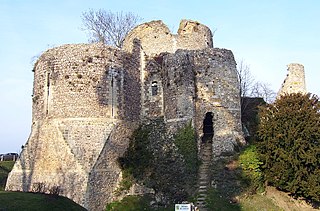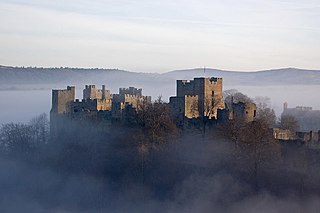Related Research Articles
Raoul II de Tosny, lord of Conches-en-Ouche, was a Norman nobleman of the House of Tosny, son of Roger I of Tosny and older brother of Robert de Stafford / Tosny. He was active in Normandy, England and Wales.
Robert de Stafford was an Anglo-Norman nobleman, a member of the House of Tosny and the first feudal baron of Stafford in Staffordshire in England, where he probably built a baronial castle. His many landholdings are listed in the Domesday Book of 1086.

Roger I of Tosny or Roger of Hispania was a Norman nobleman of the House of Tosny who took part in the Reconquista of Iberia.

The House of Tosny was an important noble family in 10th and 11th century Normandy, though it did not include any comtes or vicomtes. Its founder was Raoul I of Tosny.
Lucy of Bolingbroke or Lucia Thoroldsdottir of Lincoln was an Anglo-Norman heiress in central England and, later in life, countess of Chester. Probably related to the old English earls of Mercia, she came to possess extensive lands in Lincolnshire which she passed on to her husbands and sons. She was a notable religious patron, founding or co-founding two small religious houses and endowing several with lands and churches.

Pain fitzJohn was an Anglo-Norman nobleman and administrator, one of King Henry I of England's "new men", who owed their positions and wealth to the king.
Geoffrey Ridel was a landholder and royal justice during the reign of King Henry I of England.
Roger de Valognes was an Anglo-Norman nobleman who held lands around Benington in Hertfordshire, a tenure that made Roger the feudal baron of Benington. In 1136 he was a supporter of King Stephen of England's seizure of the English throne from Matilda, the daughter of the previous king, Henry I. Roger built Benington Castle and gave lands to Binham Priory in the early part of Stephen's reign, but was dead by 1142. His barony passed to his first two sons in succession and his third son became a royal official in Scotland.

Walter de Lacy was a Norman nobleman who went to England after the Norman Conquest of England in 1066. He received lands in Herefordshire and Shropshire, and served King William I of England by leading military forces during 1075. He died in 1085 and one son inherited his lands. Another son became an abbot.

The House of Laval is a family of barons, later counts, coming from the town of Laval, located in Northwestern France, part of the province of Maine before the French Revolution. The Laval were one of the most powerful families of Maine during the Middle Ages and also had a presence in Brittany, where their prestige was similar to that of the Rohan. The House of Laval played a significant role in Breton history and during the Hundred Years War and the French Wars of Religion. They also favored the French Renaissance in Northwestern France, building several châteaux. The last male heir died during the 17th century, and his possessions went to the House of La Trémoille.
William of Évreux or William d'Évreux was a member of the House of Normandy who played an influential role during the Norman conquest of England, one of the few Norman aristocrats documented to have been with William I at Hastings. He was the count of Évreux in Normandy as well as additional lands and expanded his holdings by consenting to the marriage of his young ward and niece Bertrade to Fulk the Rude of Anjou, whose support against the Manceaux rebels was important for William's liege Robert Curthose. A feud between William's wife Helvise or Heloise of Nevers and Isabel of Conches, the wife of Raoul II of Tosny, led to open war between the two men. Helvise also governed Évreux in William's infirm old age until her own death. Having no children of his own, William was succeeded at Évreux by his sister's son Amaury of Montfort.
Hugh de Cressy was an Anglo-Norman administrator and nobleman. Little is known of his ancestry and he first served two brothers of King Henry II of England before becoming a royal official. He was rewarded with a marriage to an heiress for his service to the king. In England he often served as a royal justice and witnessed documents, which showed his closeness to the king. On the continent, he recruited mercenaries for the royal army and was named constable of the castle of Rouen in the royal lands in France. He died in 1189 after giving lands to various monasteries before his death.
Sybil was an Anglo-Norman noblewoman in 12th-century England. Her parentage is unclear, but her first marriage to Pain fitzJohn is well-attested. Through her marriage, Sybil transferred lands in several shires to her husband, including lands around Ludlow Castle and the castle itself. After Pain's death in 1137, Sybil attempted to retain control of Ludlow and her lands but in 1139 King Stephen of England married her to Josce de Dinan, who died in 1166. Sybil had two daughters with Pain and is probably the mother of Josce's two daughters also. Sybil's marriage to Josce, and his control of Ludlow in right of his wife forms the background to a medieval Welsh romance, Fouke le Fitz Waryn.
William Meschin was an Anglo-Norman nobleman and baron. The brother of the earl of Chester, he participated in the First Crusade. After returning to England, he acquired lands from King Henry I of England and by his marriage to an heiress. He built Egremont Castle on one parcel and with his wife funded two religious foundations. After he died, his estates were divided amongst his three daughter's descendants.
Robert fitzRoger was an Anglo-Norman nobleman and Sheriff of Norfolk and Suffolk and Northumberland. He was a son of Roger fitzRichard and Adelisa de Vere. FitzRoger owed some of his early offices to William Longchamp, but continued in royal service even after the fall of Longchamp. His marriage to an heiress brought him more lands, which were extensive enough for him to be ranked as a baron. FitzRoger founded Langley Abbey in Norfolk in 1195.
Hasculf de Tany was an Anglo-Norman nobleman who lived in medieval England, in the region of London. He is believed to have been castellan of the Tower of London.
Walter de Clare or Walter fitzRichard was an Anglo-Norman nobleman and founder of Tintern Abbey. A member of a powerful family, Walter was a younger son who was given lands around Chepstow Castle by King Henry I of England sometime before 1119. Walter continued to appear in Henry's charters for the rest of the reign, and was an early supporter of King Stephen of England, Henry's successor as king. Walter last appears in the historical record in 1136 and died without children. His lands went to his nephew.
Godric or Godric the Steward or Godric dapifer was an Englishman around the time of the Norman Conquest.
Robert de Todeni, also known as Robert of Belvoir was an Anglo-Norman nobleman who held lands in England after the Norman Conquest.
Richard I of Beaumont,, viscount of Beaumont, Fresnay and Sainte-Suzanne. He initially supported Arthur of Brittany against King John of England but by September 1199, he had join John's forces. It was at his castle, Bourg-le-roi, that King John gained the support of William des Roches. Richard died sometime before October 1201.
References
- ↑ Wareham, Andrew (1999). "Two Models of Marriage: Kinship and the Social Order in England and Normandy". In Bijsterveld, A.J.A. (ed.). Negotiating Secular and Ecclesiastical Power. Brepols. pp. 107–132.
- ↑ Traill, Vanessa Josephine (2013). The Social & Political Networks of the Anglo-Norman Aristocracy: The Clare, Giffeard & Tosny Kin-groups, c.940 to c.1200 (PhD thesis). University of Glasgow.
- 1 2 Moore, James (2017). The Norman Aristocracy in the Long Eleventh Century: Three Case Studies (PhD thesis). University of Oxford.
- 1 2 Keats-Rohan 1993, p. 33.